新概念英语第一册 词组和短语 汇总
- 格式:xls
- 大小:73.50 KB
- 文档页数:5
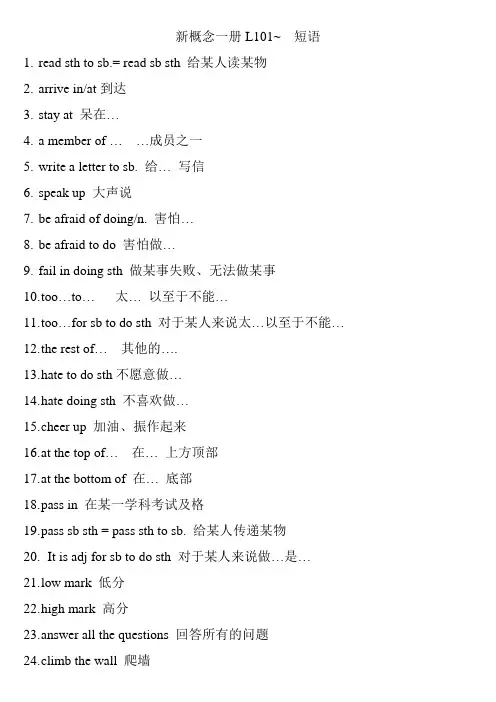
新概念一册L101~ 短语1.read sth to sb.= read sb sth 给某人读某物2.arrive in/at到达3.stay at 呆在…4.a member of ……成员之一5.write a letter to sb. 给…写信6.speak up 大声说7.be afraid of doing/n. 害怕…8.be afraid to do 害怕做…9.fail in doing sth 做某事失败、无法做某事10.t oo…to…太…以至于不能…11.t oo…for sb to do sth 对于某人来说太…以至于不能…12.t he rest of…其他的….13.h ate to do sth不愿意做…14.h ate doing sth 不喜欢做…15.c heer up 加油、振作起来16.a t the top of…在…上方顶部17.a t the bottom of 在…底部18.p ass in 在某一学科考试及格19.p ass sb sth = pass sth to sb. 给某人传递某物20.It is adj for sb to do sth 对于某人来说做…是…21.l ow mark 低分22.h igh mark 高分23.a nswer all the questions 回答所有的问题24.c limb the wall 爬墙25.w ant sb (not) to do (不)想让某人做某事26.s peak to sb 与…说话27.t ell sb (not) to do sth 告诉某人(不)做某事28.H ow do you spell ….? 如何拼写….?29.b e full of= be filled with 装满了…30.be sorry about…对…感到抱歉31.h elp sb do sth 帮助某人做某事32.help sb with sth 在某方面帮助某人33.b e/get in fashion 流行…34.b e/get out of fashion …过时35.t ry to do sth 尽力、设法做某事36.t ry doing sth 尝试做某事37.t ry on 试穿38.h ave a try 试一试39.a s well=too 也40.n ot …at all 根本不41.s how sb sth= show sth to sb. 给某人展示某物42.m ust be 一定是…43.W ould you like to do/n.….?= Do you want to do/n.…?44.m ake some coffee 煮咖啡45.b e/get ready for sth 为某事做好准备46.b e/get ready to do sth 准备好做某事47.a little 一点,少许48.l ess than 少于…49.l ess…than 不如…50.b e enough for sb. (to do sth) 对于某人来说足够(做….)51.M ay I …? 我可以…吗?52.i nstead of…用…代替…53.a dvise sb to do sth 建议某人做某事54.H ow much do/does sth cost?= What’s the price of…? …多少钱?55.c an(’t) afford (不)能付得起56.a s…as=so …as 像…一样57.n ot as…as= not so…as 不像…一样58.o ne … the other 一个…另一个…59.b e worth doing sth 值得做某事60.b e worth+价钱某物值…钱61.p ay for 付款62.p ay…for…为…付多少钱63.o n instalments 分期付款64.a deposit of 预付定金65.s ome of the passengers 一些乘客66.e ither of 两者之一…67.n either of…全不…68.b oth of…两者都…69.a ll of…全都…70.g et on 上车71.g et off 下车72.e ither … or …或者…或者…/ 要么…要么…73.n either … nor …既不…也不…74.b oth… and…. 既…又…/…和…75.b e at home/work/school 在家/工作/学校76.k nock at…敲…77.i nvite sb to do sth 邀请某人做某事78.i nvite sb for spl 邀请某人去某地79.l et sb do sth 让某人做某事80.t he front/back door 前/后门81.n ice and = very/quite 非常、相当82.c ome and do sth 过来做…83.a glass of beer 一杯啤酒84.b e asleep= fall asleep 入睡85.l ook for 寻找86.a pair of glasses 一副眼镜87.g o into 走进…里88.g o/come out of…走出…89.o n the floor 在地板上90.h ere and there =everywhere 到处、处处91.p ut sth into spl 把某物放进…里92.t ake sth out …from…把…从某地拿出来93.b e late for 迟到94.d o the housework 做家务95.d o one’s homework 做作业96.p hone sb=call sb 给…打电话97.h as been to spl 去过某地98.t ell a story /tell stories 讲故事99.a friend of mine 我的一个朋友100.climb into…爬进…里101.turn on/off 打开/关上102.sth happen to sb 某事发生在某人身上103.as adj/adv as sb can= as adj/adv as possible 某人尽可能……104.go back to sleep 继续睡觉105.run away 逃跑106.finish doing sth 完成做某事107.the price of……的价钱108.go on holiday 度假109.take an exam(ination) 参加考试。
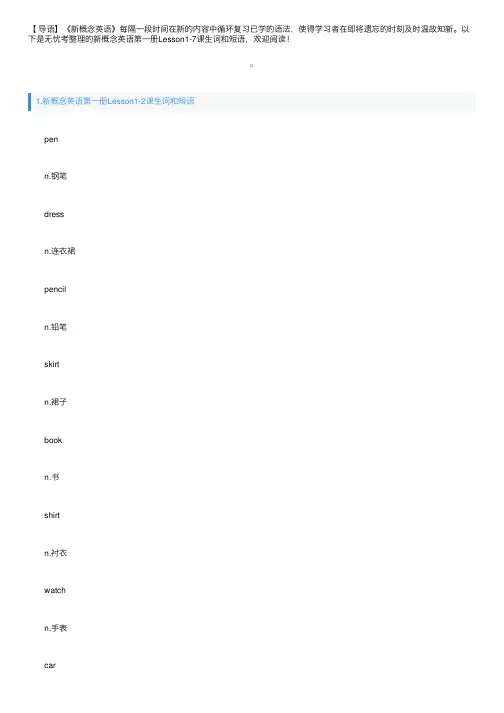
【导语】《新概念英语》每隔⼀段时间在新的内容中循环复习已学的语法,使得学习者在即将遗忘的时刻及时温故知新。
以下是⽆忧考整理的新概念英语第⼀册Lesson1-7课⽣词和短语,欢迎阅读!1.新概念英语第⼀册Lesson1-2课⽣词和短语 pen n.钢笔 dress n.连⾐裙 pencil n.铅笔 skirt n.裙⼦ book n.书 shirt n.衬⾐ watch n.⼿表 car n.⼩汽车 coat n.上⾐,外⾐ house n.房⼦2.新概念英语第⼀册Lesson3课⽣词和短语 umbrella /ʌmˈbrelə/ n. 伞 number /'nʌmbə/ n. 号码 please /pliːz/ int. 请 five /faiv/ num. 五 here /hɪə/ adv. 这⾥ sorry /ˈsɒri/ adj. 对不起的 my /maɪ/ possessive adjective 我的 sir /sɜ:/ n. 先⽣ ticket /'tikit/ n. 票 cloakroom /'kləʊkruːm/ n. ⾐帽存放处3.新概念英语第⼀册Lesson5课⽣词和短语 Mr./'mistə/ 先⽣ German /'dʒә:mən/ adj. &n. 德国⼈ good /gud/ adj. 好 nice /nais/ adj. 美好的 morning/'mɔ:niŋ/ n. 早晨 meet /mi:t/ v. 遇见 Miss /mis/ ⼩姐 Japanese /dʒæp'ni:z/ adj. & n. ⽇本⼈ new /nju:/ adj. 新的 Korean /kɔ'riən/adj. & n. 韩国⼈ student /'stju:dənt/ n. 学⽣ Chinese /'tʃai'ni:z/ adj. & n. 中国⼈ French /frentʃ/ adj. &n. 法国⼈ too /tu:/ adv. 也4.新概念英语第⼀册Lesson6课⽣词和短语 make /meik/ n. (产品的)牌号 Mercedes /mə'seidi:z/ n. 梅赛德斯 Swedish /'swi:diʃ/adj. 瑞典的 Toyota /'təujəutə/ n. 丰⽥ English /'Iŋgliʃ/ adj. 英国的 Daewoo /'da:wu:/ n. ⼤宇 American /ə'merikən/ adj. 美国的 Mini /'mini/ n. 迷你 Italian /i'tæliən/ adj. 意⼤利的 Ford /fɔ:d/ n. 福特 Volvo /'vɔlvəu/ n. 沃尔沃 Fiat /'fi:æt/ n. 菲亚特 Peugeot /'pə:'ʒəu/ n. 标致5.新概念英语第⼀册Lesson7课⽣词和短语 I /ai/ pron. 我 nationality /'næʃə'næliti/ n. 国籍 am /æm/ v. be 动词现在时第⼀⼈称单数 job /dʒɔb/ n. ⼯作 are/a:/ v. be 动词现在时复数 keyboard /'ki:bɔ:d/ n. 电脑键盘 name /neim/ n. 名字 operator /'ɔpəreitə/ n. 操作⼈员 what /wɔt/ adj. & pron. 什么 engineer /endʒi'niə/ n. ⼯程师。
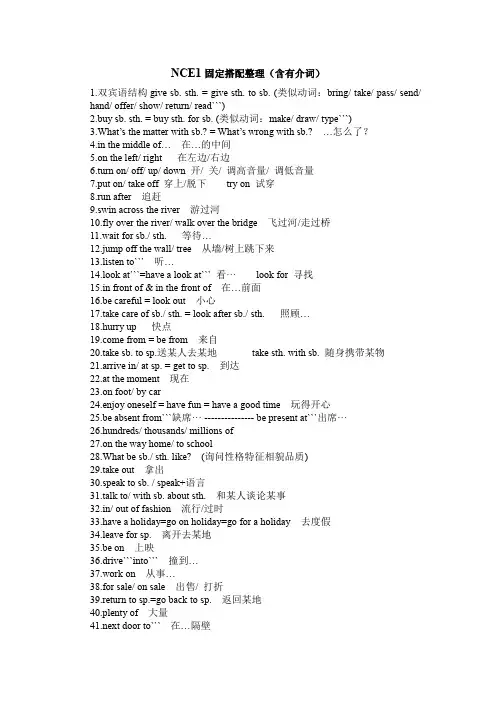
NCE1固定搭配整理(含有介词)1.双宾语结构give sb. sth. = give sth. to sb. (类似动词:bring/ take/ pass/ send/ hand/ offer/ show/ return/ read```)2.buy sb. sth. = buy sth. for sb. (类似动词:make/ draw/ type```)3.What’s the matter with sb.? = What’s wrong with sb.? …怎么了?4.in the middle of… 在…的中间5.on the left/ right 在左边/右边6.turn on/ off/ up/ down 开/ 关/ 调高音量/ 调低音量7.put on/ take off 穿上/脱下try on 试穿8.run after 追赶9.swin across the river 游过河10.fly over the river/ walk over the bridge 飞过河/走过桥11.wait for sb./ sth. 等待…12.jump off the wall/ tree 从墙/树上跳下来13.listen to``` 听…14.look at```=have a look at``` 看··· look for 寻找15.in front of & in the front of 在…前面16.be careful = look out 小心17.take care of sb./ sth. = look after sb./ sth. 照顾…18.hurry up 快点e from = be from 来自20.take sb. to sp.送某人去某地take sth. with sb. 随身携带某物21.arrive in/ at sp. = get to sp. 到达22.at the moment 现在23.on foot/ by car24.enjoy oneself = have fun = have a good time 玩得开心25.be absent from```缺席··· --------------- be present at```出席···26.hundreds/ thousands/ millions of27.on the way home/ to school28.What be sb./ sth. like? (询问性格特征相貌品质)29.take out 拿出30.speak to sb. / speak+语言31.talk to/ with sb. about sth. 和某人谈论某事32.in/ out of fashion 流行/过时33.have a holiday=go on holiday=go for a holiday 去度假34.leave for sp. 离开去某地35.be on 上映36.drive```into``` 撞到…37.work on 从事…38.for sale/ on sale 出售/ 打折39.return to sp.=go back to sp. 返回某地40.plenty of 大量41.next door to``` 在…隔壁42.belong to sb.43.at once=right away=immediately 立刻44.speak up大声地说45.hear from sb.收到某人的来信46.too+adj./adv. (For sb.) to do sth.47.so+adj./adv.+that 从句48.adj./adv.+enough for sb. to do sth.49.be full of50.be sorry sbout 对…感到抱歉51.present sth. to sb. = present sb. with sth.52.few/ a few+ c.pl. little/ a little+ u.53.(not) as/so```as```54.buy sth. on instalments 分期付款买某物55.pay a deposit of``` 付…定金56.one```the other```57.get on/ off the bus get in/ out of the car58.none = no+ n. = not any +n.59.invite sb. to sp.60.sth. happen to sb. 发生在某人身上61.sb. happen to sb. 某人碰巧做某事62.a trip to sp.63.have to & must64.by oneself= on one’s own= alone 独自65.at least/ most 至少/最多less/ more than 少于/多于66.be famous for/ as 因为···/作为···而著名67.must/ can’t be +n./adj./doing sth. 对现在事实的肯定/否定猜测must/ can’t have been +n./adj./doing sth. 对过去事实的肯定/否定猜测68.in the end= at last= finally69.be worried aboutbe interested inbe excited about70.in the future 在将来71.get married 结婚72.depend on 依靠; 取决于73.travel around the world 环游世界74.be late for school/ class/ work 上学/上课/上班迟到75.by the way 顺便说一下76.make up her face 打扮77. put away 收好78.go for a walk = have/ take a walk 去散步79.keep + n. + adj. 使···保持···80.make + n. + adj. 使···怎么样81.be surrounded by``` 被…包围82.be covered with``` 被。

3.go to work/class 新概念英语第一册知识点归纳与讲解4.be ill短语、词组归纳5.have a look/seat 词组很多。
复习时由动词开头构成的短语、6.have supper 应分类处理:7.1ook young 一、动词+介词8.go shopping 看上去look like … 1.look at…看…,9.watch TV/games 像……,10. play games look after …照料…介词短语聚焦2.listen to…听……所构成的短语称为代词”+名词/“介词3.welcome to…欢迎到……常用的介词短语Unitsl-16介词短语。
say hello to 4.…向……问好现将…对……说话按用法进行归类。
5.speak to,表示使用某种衣帽等此类短语相当于及物动词,其后必须带宾/颜色/ 1.in+语言in the 语,但宾语无论是名词还是代词,都要放在,语言或穿着……。
如:in Englishhat介词之后。
如:,表等2.in + Row/ Team/ Class/ Grade bike. This is my new Please lookit年级”等。
班级/ 示“在……排/队/after.(×) This is my new bike. Please look after in the morning/ afternoon/ evening/3.傍晚”等一段时间。
下午/表示“在上午√it.()/等om .+副词 in the desk/ pencil-box/bedro4二、动词。
副词”所构成的短语义分为两类:“动词+ /卧室里”表示“在书桌/铅笔盒非树本身表示“在树上 vt.A.动词()+副词 (in the tree5.为树本表示“在树上(;on the tree所有).脱下take on 1.put 穿上 2.off 3write ”tree. in the There are some down记下”身所有)。
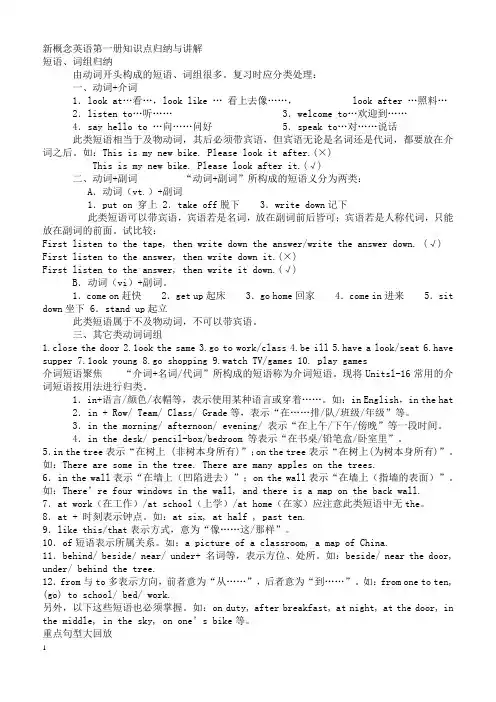
新概念英语第一册知识点归纳与讲解短语、词组归纳由动词开头构成的短语、词组很多。
复习时应分类处理:一、动词+介词1.look at…看…,look like … 看上去像……,look after …照料…2.listen to…听…… 3.welcome to…欢迎到……4.say hello to …向……问好 5.speak to…对……说话此类短语相当于及物动词,其后必须带宾语,但宾语无论是名词还是代词,都要放在介词之后。
如:This is my new bike. Please look it after.(×)This is my new bike. Please look after it.(√)二、动词+副词“动词+副词”所构成的短语义分为两类:A.动词(vt.)+副词1.put on 穿上 2.take off脱下 3.write down记下此类短语可以带宾语,宾语若是名词,放在副词前后皆可;宾语若是人称代词,只能放在副词的前面。
试比较:First listen to the tape, then write down the answer/write the answer down. (√) First listen to the answer, then write down it.(×)First listen to the answer, then write it down.(√)B.动词(vi)+副词。
1.come on赶快 2.get up起床 3.go home回家 4.come in进来 5.sit down坐下 6.stand up起立此类短语属于不及物动词,不可以带宾语。
三、其它类动词词组1.close the door2.1ook the same3.go to work/class4.be ill5.have a look/seat6.have supper7.1ook young8.go shopping9.watch TV/games 10. play games介词短语聚焦“介词+名词/代词”所构成的短语称为介词短语。
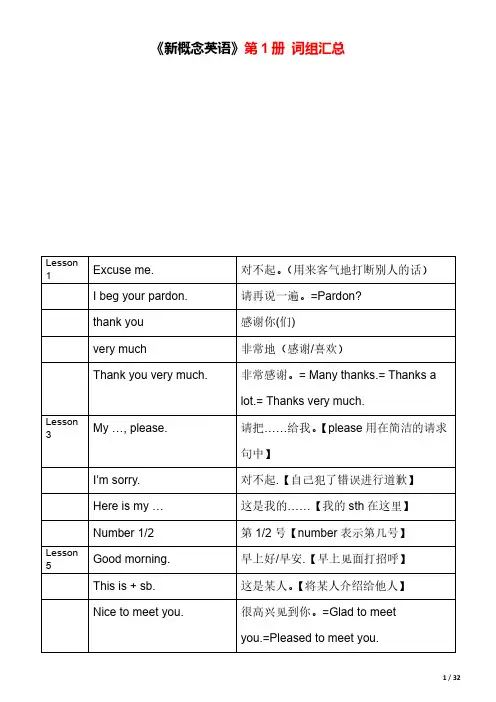

新概念第一册词组总汇公司内部编号:(GOOD-TMMT-MMUT-UUPTY-UUYY-DTTI-《新概念第一册词组总汇》Lesson 1~ 2Excuse me. 对不起。
I beg your pardon. 请再说一遍。
thank you 感谢你(们)very much 非常地Thank you very much 非常感谢= Many thanks.= Thanks a lot.= Thanks very much.You’re welcome. 不必谢。
That’s all right. 没关系 / 不客气。
= That’s OK.= Not at all.It was nothing. 没什么。
It’s a pleasure. 我很乐意。
= My pleasure。
Lesson 3~ 4I’m sorry. 对不起.Lesson 5~ 6Good morning. 早上好.This is + 人名将某人介绍给他人Nice to meet you. 很高兴见到你。
Nice to meet you, too. 我也很高兴见到你。
Glad to meet you. 很高兴见到你。
Pleased to meet you. 很高兴见到你。
How do you do 你好!what make 什么牌子an new student 一个新学生Lesson 7~ 8what nationality 什么国籍What’s your job 你是做什么工作的a keyboard operator 电脑操作人员an engineer 一个工程师Lesson 9~ 10How are you 你好吗I’m fine. 我很好。
= I’m very well.How have you been 你近况如何How is everything going on 一切都好吗Just fine. 还好。
Just so so. 马马虎虎。
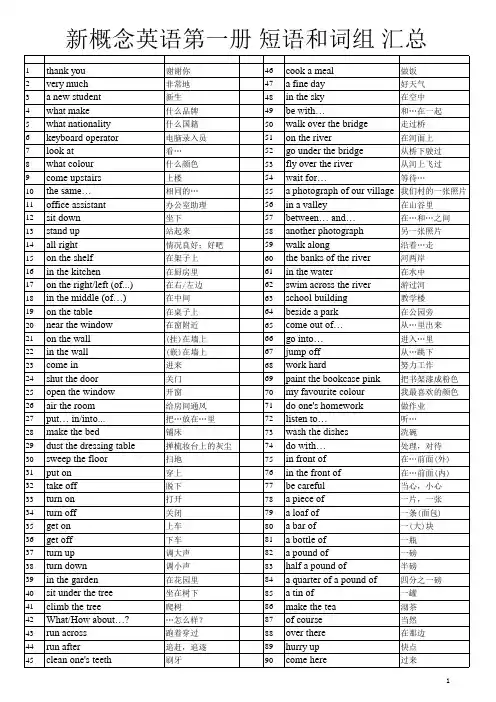

新概念一册短语大全 Document serial number【KK89K-LLS98YT-SS8CB-SSUT-SST108】《新概念第一册词组总汇》Lesson 1~ 2Excuse me. 对不起。
I beg your pardon. 请再说一遍。
thank you 感谢你(们)very much 非常地Thank you very much 非常感谢= Many thanks.= Thanks a lot.= Thanks very much.You’re welcome. 不必谢。
That’s all right. 没关系 / 不客气。
= That’s OK.= Not at all.It was nothing. 没什么。
It’s a pleasure. 我很乐意。
= My pleasure。
Lesson 3~ 4I’m sorry. 对不起. Lesson 5~ 6Good morning. 早上好.This is + 人名将某人介绍给他人Nice to meet you. 很高兴见到你。
Nice to meet you, too. 我也很高兴见到你。
Glad to meet you. 很高兴见到你。
Pleased to meet you. 很高兴见到你。
How do you do 你好!what make 什么牌子an new student 一个新学生Lesson 7~ 8what nationality 什么国籍What’s your job 你是做什么工作的a keyboard operator 电脑操作人员an engineer 一个工程师Lesson 9~ 10 How are you 你好吗I’m fine. 我很好。
= I’m very well.How have you been 你近况如何How is everything going on 一切都好吗Just fine. 还好。
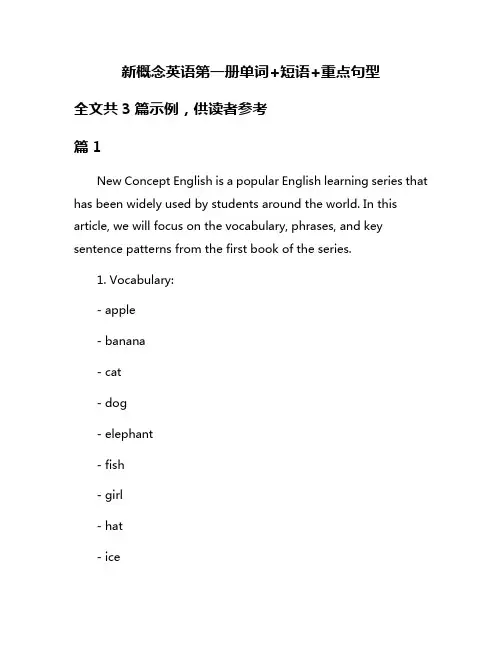
新概念英语第一册单词+短语+重点句型全文共3篇示例,供读者参考篇1New Concept English is a popular English learning series that has been widely used by students around the world. In this article, we will focus on the vocabulary, phrases, and key sentence patterns from the first book of the series.1. Vocabulary:- apple- banana- cat- dog- elephant- fish- girl- hat- ice- jam- kite- lemon2. Phrases:- How are you?- I am fine, thank you. - What's your name?- My name is Peter.- Where are you from? - I am from China.- What do you do?- I am a student.3. Key sentence patterns: - This is a cat.- That is a dog.- These are apples.- Those are bananas.- I like ice cream.- She likes chocolate.- He doesn't like fish.- They don't like lemons.- Do you have a hat?- Does she have a kite?By mastering the vocabulary, phrases, and key sentence patterns in the first book of New Concept English, you will be well on your way to improving your English language skills. Practice speaking and writing sentences using these words and phrases, and soon you will be able to communicate effectively in English. Remember, practice makes perfect!篇2New Concept English Book One includes a variety of vocabulary, phrases, and key sentence structures that are essential for English language learners. In this document, we will explore some of the key elements covered in the first book of the New Concept English series.Vocabulary:The first book of New Concept English introduces basic vocabulary that is commonly used in everyday conversations. Some of the key words covered in Book One include:- apple- ball- cat- dog- egg- father- good- house- it- juiceThese words are fundamental for English language learners and provide a solid foundation for building up vocabulary in later lessons.Phrases:In addition to individual words, the first book of New Concept English also introduces useful phrases that are commonly used in English. These phrases help learners understand how words are used together to convey meaning. Some of the key phrases covered in Book One include:- How old are you?- What's your name?- Where do you live?- I am a student.- Can you help me?- I like your dog.- Please give me a glass of water.These phrases provide learners with practical language skills that can be applied in real-life situations.Key Sentence Structures:Finally, the first book of New Concept English focuses on key sentence structures that are essential for constructing sentences in English. These structures help learners understand how toform sentences correctly and communicate effectively. Some of the key sentence structures covered in Book One include:- Subject + Verb (e.g., I read)- Subject + Verb + Object (e.g., They eat apples)- Subject + Verb + Adjective (e.g., She is happy)- Question form (e.g., Where are you from?)- Imperative form (e.g., Please listen)- Present continuous tense (e.g., She is cooking)By mastering these key sentence structures, learners can improve their speaking and writing skills in English.Overall, the first book of New Concept English provides learners with a solid foundation in vocabulary, phrases, and key sentence structures that are essential for English language proficiency. By studying these elements, learners can improve their language skills and communicate effectively in English.篇3Title: New Concept English Book One Vocabulary, Phrases, and Key Sentence PatternsNew Concept English Book One is a popular English learning material for beginners. In this document, we will explore the vocabulary, phrases, and key sentence patterns covered in the first book to help students enhance their understanding and mastery of the English language.1. Vocabulary:- English words: These include basic nouns, verbs, adjectives, and adverbs that are essential for building a strong foundation in English. Examples of common English words found in Book One include "apple," "eat," "good," and "quickly."- Collocations: Collocations are combinations of words that frequently appear together and have a specific meaning. Examples from Book One are "have breakfast," "take a shower," "play football," and "make a cake."- Idioms: Idioms are phrases that have a figurative meaning different from the literal meaning of the individual words. Idioms in Book One include "hit the nail on the head," "cost an arm and a leg," "beyond one's wildest dreams," and "rain cats and dogs."2. Phrases:- Daily routines: Phrases relating to daily activities such as waking up, brushing teeth, having breakfast, going to work, andgoing to bed are commonly used in everyday conversations and are covered in Book One.- Expressing likes and dislikes: Phrases such as "I enjoy watching movies," "I don't like spicy food," "He loves reading books," and "She hates cleaning the house" are useful for expressing preferences.- Describing people and objects: Phrases to describe physical appearance, personality traits, and characteristics of people and objects are important for effective communication. Examples include "She has long curly hair," "He is very friendly," "The car is old and rusty," and "The book is interesting and informative."3. Key Sentence Patterns:- Simple Present Tense: The simple present tense is used to describe habitual actions, general truths, and permanent situations. Key sentence patterns in the simple present tense include "She eats fruit every day," "Water boils at 100 degrees Celsius," and "I live in a big city."- Present Continuous Tense: The present continuous tense is used to describe actions happening at the moment of speaking or temporary situations. Key sentence patterns in the presentcontinuous tense include "I am watching TV right now," "They are playing football in the park," and "She is studying for her exams."- Modal Verbs: Modal verbs such as can, could, may, might, will, would, shall, should, must, and ought to are used to express abilities, possibilities, obligations, and preferences. Key sentence patterns with modal verbs include "I can swim," "He should study harder," and "She must be at home."In conclusion, mastering the vocabulary, phrases, and key sentence patterns in New Concept English Book One is essential for students to improve their English language skills and enhance their overall communication abilities. By studying and practicing these elements, students can become more confident and proficient in speaking, listening, reading, and writing in English.。
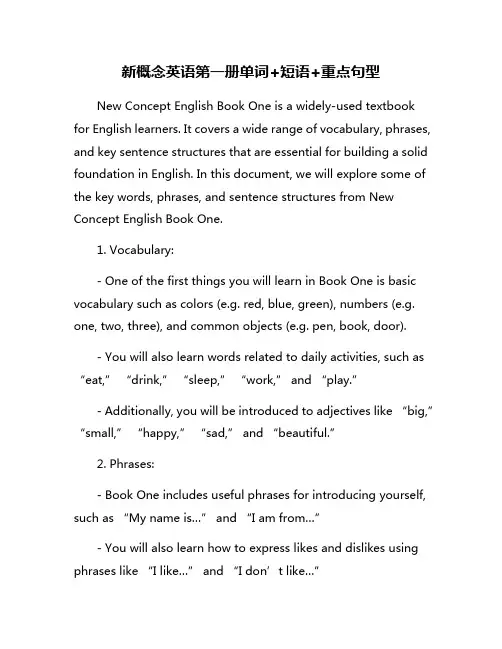
新概念英语第一册单词+短语+重点句型New Concept English Book One is a widely-used textbookfor English learners. It covers a wide range of vocabulary, phrases, and key sentence structures that are essential for building a solid foundation in English. In this document, we will explore some of the key words, phrases, and sentence structures from New Concept English Book One.1. Vocabulary:- One of the first things you will learn in Book One is basic vocabulary such as colors (e.g. red, blue, green), numbers (e.g. one, two, three), and common objects (e.g. pen, book, door).- You will also learn words related to daily activities, such as “eat,” “drink,” “sleep,” “work,” and “play.”- Additionally, you will be introduced to adjectives like “big,” “small,” “happy,” “sad,” and “beautiful.”2. Phrases:- Book One includes useful phrases for introducing yourself, such as “My name is…” and “I am from…”- You will also learn how to express likes and dislikes using phrases like “I like…” and “I don’t like…”- In addition, there are phrases for asking for information, such as “What’s your name?” and “Where are you from?”3. Key Sentence Structures:- Book One introduces basic sentence structures, such as subject-verb-object (e.g. “I love you”), questions (e.g. “D o you like ice cream?”), and negatives (e.g. “I don’t speak Japanese”).- You will also learn how to use simple present tense (e.g. “He eats breakfast every morning”) and present continuous tense (e.g. “They are playing football”).- Furthermore, you will practice forming simple sentences with conjunctions like “and” and “but” (e.g. “She is tall and beautiful”).Overall, New Concept English Book One provides a solid foundation for English language learners by introducing basic vocabulary, phrases, and key sentence structures. By mastering these elements, students will build confidence in their English communication skills and be better prepared to progress to more advanced levels of English learning.。
新概念一册常用词组与语言点(完整版)1.劳驾、对不起打扰一下Excuse me.2.早上好good morning3.下午好good afternoon4.上楼come upstairs5.什么颜色what color6.来见见come and meet7.您好How do you do?8.给某人某物give sb.sth=give sth to sb9.不是那些not those10.架子上的那些the ones on the shelf11.在架子上on the shelf12.在右边on the right13.在左边on the left14.在……中间in the middle of…15.在桌子上on the table16.在厨房in the kitchen17.在盘子上on the plate18.在地板上on the floor19.靠近门near the door20.在床上on the bed21.在冰箱里in the refrigerator22.在房间里in the room23.进来come in24.开门open the door25.关门shut the door26.必须做must do27.是房间通风air the room28.整理床铺、铺床make the bed29.梳妆台dressing table30.打开(电视机、电灯、收音机等)turn on 31.关(电视机、电灯、收音机等)turn off32.脱掉take off33.穿上put on34.追逐run after35.在河面上on the river36.在花园里in the garden37.在树底下under the tree38.…怎么样?What about…?=How about…?39.做…怎么样?What about=How about=Would you like=Do you want…40.爬树climb the tree41.请你再说一遍pardon=I beg your pardon=pardon me?42.好天气、晴天a fine day43.和家人在一起be with families44.从…上空飞过fly over45.看…look at46.在天上in the sky47.桥底下under the bridge48.做作业do one’s homework49.掉下、跳离jump off50.想要做某事want to do51.做饭cook a meal52.等待wait for53.吃饭have a meal54.照顾look after=take care of55.洗盘子、刷盘子wash the dishes56.…的一张照片a photograph of…57.在山谷中in the valley58.靠近小河on the river59.沿着…走walk along60.在水中in the water61.横渡swim across62.在公园旁边beside the park63.走出…walk out of64.走进…里go into65.做一个书架/书橱make a bookcase66.给你here you are67.打算做某事be going to do68.为…(准备的)be for sb69.最喜欢的颜色favourite colour70.等待…wait for71.刮脸shave one’s face72.听….listen to73.处理…do with=deal with74.穿上…put on75.脱掉take off76.把…放在…上put…on77.在…前面(外部)in front of78.在…前部(内部)in the front of79.小心be careful80.在架子上on the shelf81.一个可爱的花瓶a lovely vase82.给某人展示…show sb sth=show sth to sb83.带给某人某物take sb sth=take sth to sb84.送给某人某物send sb sth=send sth to sb85.一块乳酪a piece of cheese86.一块面包a loaf of bread87.一块肥皂a bar of soap88.一块巧克力a bar of chocolate89.一瓶牛奶a bottle of mike90.一英镑的糖a pound of sugar91.半磅咖啡half a pound of coffee92.四分之一磅茶a quarter of a pound of tea 93.一听烟丝a tin of tobacco94.当然certainly=of course95.沏茶make the tea96.在水壶中in the cupboard97.在那边over there98.在茶壶后面behind the teapot99.我能…但我不能…I can…but I can’t…100.在茶壶里in the teapot101.寻找look for102.快点hurry up103.到这来come here104.一会儿in a minute105.隔壁next door106.在某人的办公室in one’s office107.要求某人做某事ask sb.o do sth.108.为某人打信type a letter for sb.109.怎么了?What’s wrong?=What’s the matter?=Is there something wrong with you?110.一百、两百、三百one/two/three hundred111.数以百计的hundreds of112.数以千计的thousands of113.举起椅子lift the chair114.读书read the book115.读杂志read the magazine116.做蛋糕make a cake\make cakes117.做饼干make biscuits118.喜欢做某事(偶尔)like to do119.喜欢做某事(经常)like doing120.清咖啡black coffee121.想要做某事want to do sth.122.想要某人(不)做某事want sb.(not)to do sth.123.一磅肉馅a pound of mince124.告诉实情tell the truth125.告诉某人(不)做某事tell sb(not)to do sth.126.来自于come from=be from127.…的样子?/…怎么样?(通常用来询问某人的外貌特征或用来询问天气)what’s….like?128.在春天、夏天、秋天、冬天in spring/summer/autumn/winter 129.哪国人what nationality130.在东部in the east131.谈论的话题subject of conversation132.尽某人做大的努力做…try one’s best to do133.与…谈话之中be in conversation with sb.134.居住live in/at135.去上班go to work136.去学校go to school137.呆在家里stay at home138.在早上in the morning139.带某人去某地take sb to spl140.每天every day=each day141.吃午饭eat lunch142.吃早饭eat breakfast143.吃晚饭eat supper/dinner144.在中午at noon145.在下午in the afternoon146.会见朋友meet some friends=see some friends147.一起喝茶drink tea together148.在晚上at night149.回家come home=go home150.到家get home=arrive home151.在家be home152.上床睡觉go to bed153.乘小汽车/公共汽车/火车等by car/bus/train=take a car/bus/train 154.步行、走路on foot=walk to…155.骑自行车by bike=ride a bike156.去购物go shopping=go to the shops157.在客厅in the living room158.在花园里in the garden159.此时此刻at the moment=now160.一本有趣的书an interesting book161.做饭cook a meal162.大尺寸的the large size163.小尺寸的the small size164.一瓶胶水a bottle of glue165.就这些吗Is that all?166.一盒粉笔a box of chalk167.其他的东西something else168.给…打电话call sb169.医生的电话号码the doctor’s telephone number 170.患感冒have a cold171.患头痛have a headache172.患耳痛have an earache173.患牙痛have a toothache174.患胃痛have a stomach ache175.患流行性感冒/麻疹/腮腺炎have flu/measles/mumps 176.吃一片/一些阿司匹林have an/some aspirin/s177.吃一些药片have some medicine178.看医生see a doctor179.看牙医see a dentist180.发烧have a temperature181.上楼go upstairs182.起床get up183.患重感冒have a bad cold184.油腻的食物rich food185.拿…玩/与…玩play with186.谈论…talk about187.在图书馆in the library188.身体探出lean out of189.弄出噪音、发出声响make a noise190.…的钥匙/…的答案the key to…191.十八岁eighteen years old=eighteen-year-old192.没关系、不用谢that’s all right=not at all=you’re welcome 193.玩的愉快!Have a good time=Enjoy oneself194.独自…by oneself195.高兴做某事enjoy doing sth.196.在肉店at the butcher’s197.在蔬菜店at the greengrocer’s198.在理发店at the hairdresser’s199.在食杂店at the grocer’s200.缺席…be absent from201.上周last week202.花费…做….spend….(in)doing203.在我妈妈家stay at my mother’s204.在乡下in the country205.做礼拜at church206.在乳品店at the dairy207.在面包店at the baker’s208.参观比赛at the race209.参加比赛in the race210.在人群中in the crowd211.在回家的路上on one’s way home212.在某人去往某地的路上on one’s way to…213.在去往…的路上on the way to….214.在文具店at the stationer’s215.三次three times216.接电话answer the telephone217.我是…(电话用于)this is…218.最后at last=in the end 219.今晚tonight220.昨晚last night221.前天早上/下午/晚上the day before yesterday in the morning/afternoon/evening222.前天夜里the night before last223.去某地go to spl224.迷路lose one’s way225.在公共汽车站附近near the bus stop226.心中暗想say to oneself227.去往…的路怎么走?(问路)Can you tell me the way to…228.把…放在…里put…into229.把…从…取出/拿出take…out230.伤到某人自己hurt oneself231.向某人问好/问候某人greet oneself232.在街上in the street233.前天the day before yesterday234.努力工作work harda235.(某人)有…have got236.多大号what size237.什么颜色what colour238.上个月/星期last month/week239.一个月以前a month ago240.一双、一对儿、一副….a pair of….241.害怕做…be afraid to do242.害怕…be afraid of doing/n./pron.243.为某人弄到某物get sb sth=get sth for sb.244.前年the year before last245.大上个月the month before last246.大上个礼拜the week before last247.前年the year before last248.流行...be/get in fashion249.过时…be/get out of fashion250.看…look at251.跳下jump off252.走过walk across253.洗手wash one’s hands254.提问ask a question255.看电视watch television256.与…谈话talk to sb.257.感谢某人thank sb.258.向…问候greet sb.258.想要做某事want to do sth=would like to do sth259.想要某人(不)做某事want sb(not)to do sth=would like sb (not)to do sth260.想要成为一名…..want to be a/an….261.看牙医see the dentist262.预约have an appointment263.对于某人来说做…是紧急的/急迫的It is urgent for sb.to do sth 264.忙于做某事be busy doing sth265.忙于某事be busy with sth267.此时此刻at the moment268.写一份购物单make a shopping list269.许多a lot of=lots of270.需要某人/物need sb/sth271.需要做某事need to do sth272.需要某人做某事need sb to do sth273.(某事物)需要被…….need doing274去杂货店go to the grocer’s275.去蔬菜水果店go to the greengrocer’s276.去肉店go to the butcher’s277.根本不…not…at all278.为什么不….?Why not do….=Why don’t you do….?279.去报刊go to the newsagent’s280.去药店go to the chemist’s 281.希望做某事wish/hope to do sth282.洗澡have/take a bath283.准备好做…be/get ready to do sth 284.为…做好准备be/get ready for…285.吸烟have a cigarette286.喝一杯威士忌have a glass of whisky 287.吃晚饭have dinner288.去餐馆go to a restaurant289.喝茶have tea=drink tea290.吃饭have a meal=eat a meal291.游泳have a swim=go swimming292.理发have a haircut293.上课have a lesson294.聚会have a party=hold a party295.度假have a holiday=go for a holiday 296.玩得愉快have a good time=enjoy oneself 300.杂乱、凌乱in a mess301.把…包装打包到…里pack sth into spl. 302.走进…里go into…303.走出…go out of304.动身去某地leave for305.离开某地去某地leave….for306.呆在家里stay at home307.上映/上演be on308.回来be back309.出去be out310.关上be closed311.打开be open312.离开be away from313.结束be over314.在这be here315.在那be there316.去过某地have/has been to317.去了某地have/has gone to318.一直,始终all the time319..…的号码?What’s the number of…?320.若干、许多….a number of…..321.…的数目、数量the number of…..322.给某人带来某物bring sb sth=bring sth to sb323.记得去做某事remember to do324.记得已做过某事remember doing325.忘记去做某事forget to do sth326.忘记已做过某事forget doing sth327.完成做某事finish doing sth328.算出….work out329.从事…work on330.让某人做某事let sb do sth331.设法做某事try to do sth332.尝试做某事try doing sth333.看一看have a look334.试一试have a try335.试穿try on336.尽某人最大的努力做…try/do one’s best to do sth337.待售for sale338.出售on sale339.相信某人(所说的话)believe sb340.信任某人believe in sb341.把某物卖给某人sell sb sth=sell sth to sb342.多少(后接不可数名词)how much343.多少(后接可数名词复数)how many344.退休be retired from345.值得做某事be worth doing346.值…钱be worth+价钱347.某人花费…时间/金钱在…事情上sb spend some time/money on sth/(in)doing sth=It takes sb some time/money in doing sth/on sth 348.某物花费某人多少金钱sth cost sb some money349.决定做某事decide to do sth=make a decision to do sth 350.最后拍板have the last word351.搬到….move to352.搬进…(里)move in(to)353.搬出move out of354.错过做某事miss doing355.不擅长做…/做不好….be poor in/at sth=do badly in 356.擅长做…/能做好….be good at=do well in357.后天the day after tomorrow358.到达arrive in/at359.给…打电话call sb/(tele)phone sb.360.隔壁邻居next-door neighbour361.飞往…fly to=go to spl by plane/air362.大下个月the month after next363.返回到return to…=go back to364.大量,许多plenty of365.最好做某事had better do sth=It is better for sb to do sth 366.最好不做某事had better not do sth367.赶上某人catch up with sb368.看见某人正在做某事catch sb doing sth369.在…(时间)之后in+时间名词’s+time=in+时间名词370.前几天/年the other day/year371.把…描绘成…describe…as…372.属于…的belong to…373.偶然遇到fall across374.入睡fall asleep375.掉进、落入fall into376.伤到某人自己hurt oneself377.在…后部at the back of378.在…前部in the front of379.帮助某人做某事help sb(to)do sth=help sb with sth 380.使/让某人做某事make/have/let sb do sth381.立即、马上at once=right now=right away382.确信做某事be sure to do sth383.对某事有把握be sure of+n/doing384.read sth to sb.=read sb sth给某人读某物385.arrive in/at到达386.stay at呆在…387.a member of……成员之一388.write a letter to sb.给…写信389.speak up大声说390.be afraid of doing/n.害怕…391.be afraid to do害怕做…392.fail in doing sth做某事失败、无法做某事393.too…to…太…以至于不能…394.too…for sb to do sth对于某人来说太…以至于不能…395.the rest of…其他的….396.hate to do sth不愿意做…397.hate doing sth不喜欢做…398.cheer up加油、振作起来399.at the top of…在…上方顶部400.at the bottom of在…底部401.pass in在某一学科考试及格402.pass sb sth=pass sth to sb.给某人传递某物403.It is adj for sb to do sth对于某人来说做…是…404.low mark低分405.high mark高分406.answer all the questions回答所有的问题407.climb the wall爬墙408.want sb(not)to do(不)想让某人做某事409.speak to sb与…说话410.tell sb(not)to do sth告诉某人(不)做某事411.How do you spell….?如何拼写….?412.be full of=be filled with装满了…413.be sorry about…对…感到抱歉414.help sb do sth帮助某人做某事415.help sb with sth在某方面帮助某人416.be/get in fashion流行…417.be/get out of fashion…过时418.try to do sth尽力、设法做某事419.try doing sth尝试做某事420.try on试穿421.have a try试一试422.as well=too也423.not…at all根本不424.show sb sth=show sth to sb.给某人展示某物425.must be一定是…426.Would you like to do/n.….?=Do you want to do/n.…?427.make some coffee煮咖啡428.be/get ready for sth为某事做好准备429.be/get ready to do sth准备好做某事430.a little一点,少许431.less than少于…432.less…than不如…433.be enough for sb.(to do sth)对于某人来说足够(做….)434.May I…?我可以…吗?435.instead of…用…代替…436.advise sb to do sth建议某人做某事437.How much do/does sth cost?=What’s the price of…?…多少钱?438.can(’t)afford(不)能付得起439.as…as=so…as像…一样440.not as…as=not so…as不像…一样441.one…the other一个…另一个…442.be worth doing sth值得做某事443.be worth+价钱某物值…钱444.pay for付款445.pay…for…为…付多少钱446.on instalments分期付款447.a deposit of预付定金448.some of the passengers一些乘客449.either of两者之一…450.neither of…全不…451.both of…两者都…452.all of…全都…453.get on上车454.get off下车455.either…or…或者…或者…/要么…要么…456.neither…nor…既不…也不…457.both…and….既…又…/…和…458.be at home/work/school在家/工作/学校459.knock at…敲…460.invite sb to do sth邀请某人做某事461.invite sb for spl邀请某人去某地462.let sb do sth让某人做某事463.the front/back door前/后门464.nice and=very/quite非常、相当e and do sth过来做…466.a glass of beer一杯啤酒467.be asleep=fall asleep入睡468.look for寻找469.a pair of glasses一副眼镜470.go into走进…里471.go/come out of…走出…472.on the floor在地板上473.here and there=everywhere到处、处处474.put sth into spl把某物放进…里475.take sth out…from…把…从某地拿出来476.be late for迟到477.do the housework做家务478.do one’s homework做作业479.phone sb=call sb给…打电话480.has been to spl去过某地481.tell a story/tell stories讲故事482.a friend of mine我的一个朋友483.climb into…爬进…里484.turn on/off打开/关上485.sth happen to sb某事发生在某人身上486.as adj/adv as sb can=as adj/adv as possible某人尽可能……487.go back to sleep继续睡觉488.run away逃跑489.finish doing sth完成做某事490.the price of……的价钱491.go on holiday度假492.take an exam(ination)参加考试493.很贵的词典expensive dictionary494.我忘了…I forgot to do495.拿…take sth.with sb.496.站在柜台后面stand behind the counter497.戴上put it on498.修路repair the road499.拿篮子carry basket500.澳大利亚之行a trip to Australia501.照相take a photograph502.到…旅行时during my trip to…503.让我看看let me see504.多漂亮的船!What a beautiful ship!505.给…个工作offer sb.a job506.留胡子grow a beard507.刮了shave off508两个人一起喝茶tea for two509.喝茶have tea510.先给花园浇水water the garden first511.你一定得…吗?Do you have to….?512.恐怕我得现在浇。
新概念英语第一册短语归纳大全Lesson 1~ 2Excuse me. 对不起。
I beg your pardon. 请再说一遍。
thank you 感谢你(们)very much 非常地Thank you very much 非常感谢= Many thanks.= Thanks a lot.= Thanks very much.You're welcome. 不必谢。
That's all right. 没关系/ 不客气。
= That's OK.= Not at all.It was nothing. 没什么。
It's a pleasure. 我很乐意。
= My pleasure。
Lesson 3~ 4I'm sorry. 对不起.Lesson 5~ 6Good morning. 早上好.This is + 人名将某人介绍给他人Nice to meet you. 很高兴见到你。
Nice to meet you, too. 我也很高兴见到你。
Glad to meet you. 很高兴见到你。
Pleased to meet you. 很高兴见到你。
How do you do? 你好!what make 什么牌子an new student 一个新学生Lesson 7~ 8what nationality 什么国籍What's your job? 你是做什么工作的?a keyboard operator 电脑操作人员an engineer 一个工程师Lesson 9~ 10 How are you? 你好吗?I'm fine. 我很好。
= I'm very well.How have you been? 你近况如何?How is everything going on? 一切都好吗? Just fine. 还好。
Just so so. 马马虎虎。
新概念英语第一册经典短语1.双宾动词:give sb sth给某人某物give me a book;= give sth to sb把某物给某人give a book to himshow/send sb sth展示/发送给某人某物= show/send sth to sb把某物展示/发送给某人2,地点介词in+大地点at+小地点live at (小地点) /in(大地点)住在…arrive at/in 到达…stay at/in 呆在…3.take sb to +地点送某人去某地My father takes me to school every day .4.want sth 想要某物I want some milk.Want to do sth 想要做某事She wants to buy a new book.Want sb to do sth 想要某人做某事They want me to open the door.do/does not want sb to do sth 不想要某人做某事I do not want you to miss the train.5.get up起床I always get up at 7:00.6.keep sth +adj. 保持某物的…….Keep the floor clean7.be absent(from)缺席I was absent from school yesterday.8.on the/one’s way to在去……的路上On the way home (to school),I met an old friend.On the train to在去……的火车上9.lose one’s way 迷路=be lostI lost my way .=I was lost10.say to oneself 自言自语“I can win” I said to myself11.put sth into 把……放到……I put some money into my pocket .I put some books into my bag .12. take out取出He took out a note book and wrote them down ,13. put on your coat穿上take off your shoes脱掉turn on 打开turn off 关掉put your coat on take your shoes offput it on take them off (名词可后可中间,代词只能放中间)14. be afraid of sth 害怕I am afraid of dog .be afraid (that)+宾从恐怕……I am afraid that it will rain tomorrow .I’m afraid that I can’t do it .15.buy sth for sb 为某人买某物I bought a present for you .buy sth from sb 从某人那买某物She bought a tie from Tony . 16.hundreds of 数以百计thousands of 数以千计.17.Be in fashion 时髦Jeans are always in fashion.Be out of fashion 过时Skirts are out of fashion this year .18.till (until )直到I can arrive till(until)3:00 this afternoom.Not ……until直到..才I did n’t finish my homework until 10:00 in the evening .19.许多a lot of water(不可数)oranges (可数)many apples (可数)much meat (不可数)plenty of time(不可数)/tomatoes(可数)20.not ……at all 根本不I do n’t know her at all .I do n’t want to talk with him at all .21.have breakfast/lunch/supper/dinner /a meal /a swim/ a bath /a lesson/a holiday/a good time .have可替换其他词,表达意思。
新概念一册短语大全公司内部编号:(GOOD-TMMT-MMUT-UUPTY-UUYY-DTTI-《新概念第一册词组总汇》Lesson 1~ 2Excuse me. 对不起。
I beg your pardon. 请再说一遍。
thank you 感谢你(们) very much 非常地Thank you very much 非常感谢= Many thanks.= Thanks a lot.= Thanks very much.You’re welcome. 不必谢。
That’s all right. 没关系 / 不客气。
= That’s OK.= Not at all.It was nothing. 没什么。
It’s a pleasure. 我很乐意。
= My pleasure。
Lesson 3~ 4I’m sorry. 对不起. Lesson 5~ 6Good morning. 早上好.This is + 人名将某人介绍给他人Nice to meet you. 很高兴见到你。
Nice to meet you, too. 我也很高兴见到你。
Glad to meet you. 很高兴见到你。
Pleased to meet you. 很高兴见到你。
How do you do 你好!what make 什么牌子an new student 一个新学生Lesson 7~ 8what nationality 什么国籍What’s your job 你是做什么工作的a keyboard operator 电脑操作人员an engineer 一个工程师Lesson 9~ 10 How are you 你好吗I’m fine. 我很好。
= I’m very well.How have you been 你近况如何How is everything going on 一切都好吗Just fine. 还好。
Just so so. 马马虎虎。
Lesson 11 excuse [ik'skju:z] v.原谅2 me [mi:, mi] pron.我(宾格)3 yes [jes] ad.是的4 is [iz, s, z, əz] v.be动词现在时第三人称单数5 this [ðis] pron.这6 your [jə:, jɔ:, jər, jɔ:r] 你的,你们的7 handbag ['hændbæg] n.(女用)手提包8 pardon ['pɑ:dən] int.原谅,请再说一遍9 it [it] pron.它10 thank you 感谢你(们)11 very much 非常地Lesson 21 pen [pen] n.钢笔2 pencil ['pensl] n.铅笔3 book [buk] n.书4 watch [wɔtʃ] n.手表5 coat [kəut] n.上衣,外衣6 dress [dres] n.连衣裙7 skirt [skə:t] n.裙子8 shirt [ʃə:t] n.衬衣9 car [kɑ:] n.小汽车10 house [haus] n.房子Lesson 1~ 2Excuse me. 对不起。
I beg your pardon. 请再说一遍。
thank you 感谢你(们)very much 非常地Thank you very much 非常感谢= Many thanks.= Thanks a lot.= Thanks very much.You’re welcome. 不必谢。
That’s all right. 没关系 / 不客气。
= That’s OK.= Not at all.It was nothing. 没什么。
It’s a pleasure. 我很乐意。
= My pleasure。
Lesson 31 umbrella [ʌm'brelə] n.伞2 please [pli:z] int.请3 here [hiə] ad.这里4 my [mai] 我的5 ticket ['tikit] n.票6 number ['nʌmbə] n.号码7 five [faiv] num.五8 sorry ['sɔri] a.对不起的9 sir [sə:] n.先生10 cloakroom ['kləukru:m] n.衣帽存放处Lesson 41 suit [su:t, sju:t] n.一套衣服2 school [sku:l] n.学校3 teacher ['ti:tʃə] n.老师4 son [sʌn] n.儿子5 daughter ['dɔ:tə] n.女儿Lesson 3~ 4I’m sorry. 对不起.Lesson 51 Mr. ['mistə] 先生2 good [gud] a.好3 morning ['mɔ:niŋ] n.早晨4 Miss [mis] 小姐5 new [nju:] a.新的6 student ['stju:dənt] n.学生7 French [frentʃ] a.& n.法国人8 German ['dʒə:mən] a.& n.德国人9 nice ['nais] a.美好的10 meet [mi:t] v.遇见11 Japanese [ˌdʒæpə'ni:z] a.& n.日本人12 Korean [kə'riən] a.& n.韩国人13 Chinese [ˌtʃai'ni:z] a.& n.中国人14 too [tu:] ad.也Lesson 61 make [meik] n.(产品的)牌号2 Swedish ['swi:diʃ] a.瑞典的3 English ['iŋgliʃ] a.英国的4 American [ə'merikən] a.美国的5 Italian [i'tæliən] a.意大利的6 Volvo ['vɔlvəʊ] n.沃尔沃7 Peugeot n.标致8 Mercedes ['mə:sidi:z] n.梅赛德斯9 Toyota ['təʊjəʊtə] n.丰田10 Daewoo n.大宇11 Mini ['mini] n.迷你12 Ford [fɔ:d] n.福特13 Fiat ['faiæt, -ət] n.菲亚特Lesson 5~ 6Good morning. 早上好.This is + 人名将某人介绍给他人Nice to meet you. 很高兴见到你。